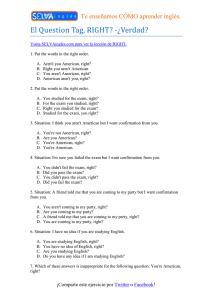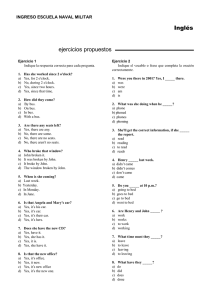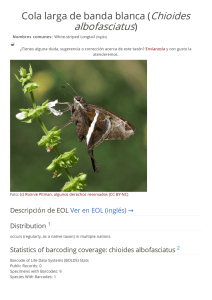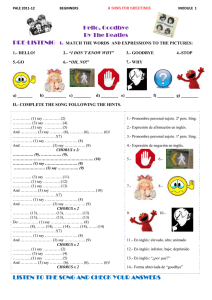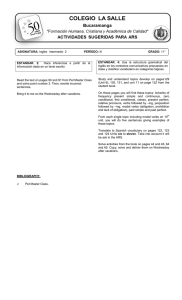Inglés II UPIBI-IPN UNIDAD
Anuncio
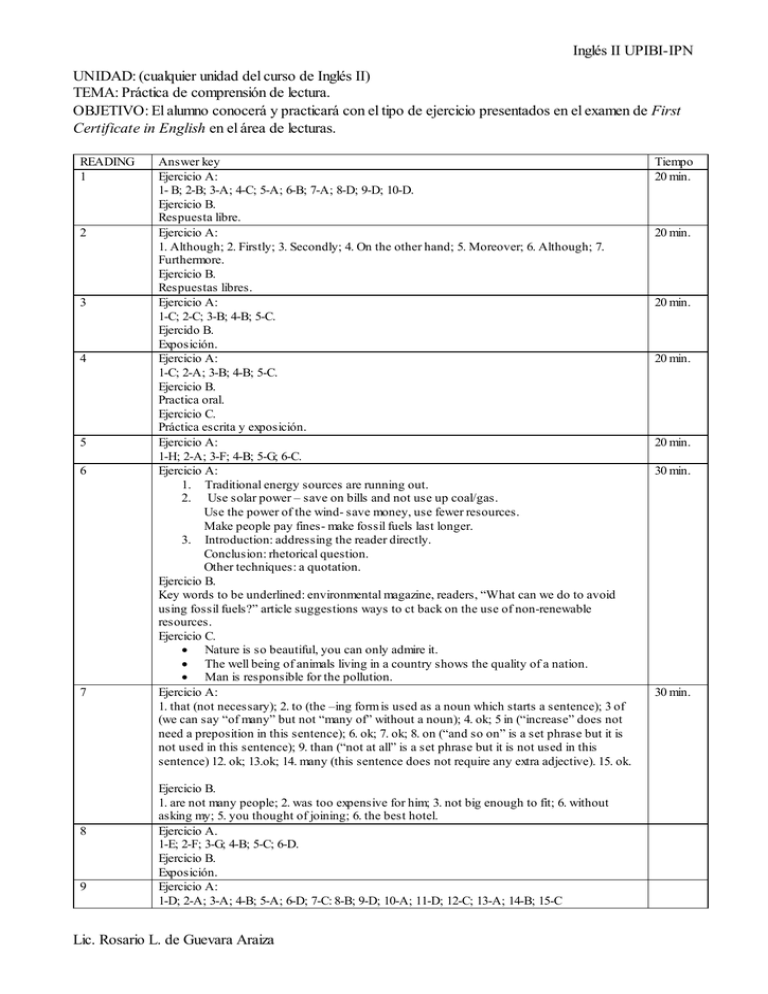
Inglés II UPIBI-IPN UNIDAD: (cualquier unidad del curso de Inglés II) TEMA: Práctica de comprensión de lectura. OBJETIVO: El alumno conocerá y practicará con el tipo de ejercicio presentados en el examen de First Certificate in English en el área de lecturas. READING 1 2 3 4 5 6 7 8 9 Answer key Ejercicio A: 1- B; 2-B; 3-A; 4-C; 5-A; 6-B; 7-A; 8-D; 9-D; 10-D. Ejercicio B. Respuesta libre. Ejercicio A: 1. Although; 2. Firstly; 3. Secondly; 4. On the other hand; 5. Moreover; 6. Although; 7. Furthermore. Ejercicio B. Respuestas libres. Ejercicio A: 1-C; 2-C; 3-B; 4-B; 5-C. Ejercido B. Exposición. Ejercicio A: 1-C; 2-A; 3-B; 4-B; 5-C. Ejercicio B. Practica oral. Ejercicio C. Práctica escrita y exposición. Ejercicio A: 1-H; 2-A; 3-F; 4-B; 5-G; 6-C. Ejercicio A: 1. Traditional energy sources are running out. 2. Use solar power – save on bills and not use up coal/gas. Use the power of the wind- save money, use fewer resources. Make people pay fines- make fossil fuels last longer. 3. Introduction: addressing the reader directly. Conclusion: rhetorical question. Other techniques: a quotation. Ejercicio B. Key words to be underlined: environmental magazine, readers, “What can we do to avoid using fossil fuels?” article suggestions ways to ct back on the use of non-renewable resources. Ejercicio C. · Nature is so beautiful, you can only admire it. · The well being of animals living in a country shows the quality of a nation. · Man is responsible for the pollution. Ejercicio A: 1. that (not necessary); 2. to (the –ing form is used as a noun which starts a sentence); 3 of (we can say “of many” but not “many of” without a noun); 4. ok; 5 in (“increase” does not need a preposition in this sentence); 6. ok; 7. ok; 8. on (“and so on” is a set phrase but it is not used in this sentence); 9. than (“not at all” is a set phrase but it is not used in this sentence) 12. ok; 13.ok; 14. many (this sentence does not require any extra adjective). 15. ok. Ejercicio B. 1. are not many people; 2. was too expensive for him; 3. not big enough to fit; 6. without asking my; 5. you thought of joining; 6. the best hotel. Ejercicio A. 1-E; 2-F; 3-G; 4-B; 5-C; 6-D. Ejercicio B. Exposición. Ejercicio A: 1-D; 2-A; 3-A; 4-B; 5-A; 6-D; 7-C: 8-B; 9-D; 10-A; 11-D; 12-C; 13-A; 14-B; 15-C Lic. Rosario L. de Guevara Araiza Tiempo 20 min. 20 min. 20 min. 20 min. 20 min. 30 min. 30 min. Inglés II UPIBI-IPN Lic. Rosario L. de Guevara Araiza Inglés II UPIBI-IPN READING 1. A. Read the text and choose the correct answer. A RAINBOW ON YOUR PLATE. Nowadays, we are all 0) ______ of the fact we 1) ______ be eating a healthy diet. We get advice from 2) ____; TV, radio, magazines, books, videos and the Internet as well 3) ____ friends, colleagues and family. Well, if you find all this advice a little confusing, then there is now a much simpler solution, dieting by color. The color Diet is 4) ____ on the theory that the natural color of food reflects 5) ____ nutritional content. For example green foods 6) ____ as broccoli, spinach and lettuce 7) ____ high levels of beta-carotene and glucose. These help reduce the risk of cancer, are a good source of iron and act as powerful antioxidants, while yellow foods like bananas, corn and lemons have potassium and vitamin C which can reduce the pain of arthritis, reduce stress and be a good source 8) ______ energy. The principles of the color diet are very easy to follow. Make sure that each meal contains a 9) ____ of colors and you will be eating a balanced, healthy died. But remember, the colors have to be natural. Eating a packet of Smartest a day will not give you anything 10) ____ toothache. 0. 1. 2. 3. 4. 5. 6. 7. 8. 9. 10. A. known A. will A. anywhere A. as A. fixed A. its A. like A. contain A. in A. pattern A. from B. unsure B. should B. everywhere. B. by B. written B. his B. such B. own B. to B. minimum B. except C. aware C. ought C. somewhere C. from C. based C. her C. similar C. need C. for C. blend C. apart D. sure D. need D. elsewhere. D. to D. formed D. their D. including D. add D. of D. variety D. but B. Now think about the most colorful meal you can prepare. Write about it without revealing what it is called. ________________________________________________________________________________ ________________________________________________________________________________ ________________________________________________________________________________ ________________________________________________________________________________ _______________________________________________________________________________. Lic. Rosario L. de Guevara Araiza Inglés II UPIBI-IPN READING 2. A. Read the article on veganism and underline the correct linking word (s) in bold. VEGAN LIVING. A large number of people do not eat meat. Vegans have taken his a step further by refusing to consume or use anything that comes from animals. This means, that not only do they not eat meat, but they do not eat fish, poultry or dairy products either. So why have vegans adopted this way of life? 1. Although / because a vegan diet may be strict, there are certain advantages to be gained. 2. For example / Firstly, because a vegan died is low in fat and cholesterol, the risk of heart diseases is reduced. 3. Secondly / To sum up, there is less pressure on farmers to keep animals under cruel conditions to produce milk, eggs and poultry. 4. On the other hand / What is more, humans are natural meat eaters and some essential ingredients in our diet can only come from animal products. For example, we cannot get enough vitamin B12 from plants, so vegans have to take this vitamin, made from yeast, as a supplement to their diet. 5. For example / Moreover, the humans digestive system cannot digest certain plant proteins, and this can lead to stomach problems. 6. Despite / Although there are some disadvantages to adopting such a strict diet, I fee that overall, it is a healthier way of life. 7. Even though / Furthermore, it is cruel to kill animals for food and if everybody adopted a vegan diet, our whole outlook on life would change for the better. B. About the article you read write three pros and three cons you find about veganism. (giving justifications) Pros. A. _________________________________. B. _________________________________. C. _________________________________. Justifications. _________________________________________. _________________________________________. _________________________________________. Cons. Justifications. 1. _________________________________. _________________________________________. 2. _________________________________. _________________________________________. 3. _________________________________. _________________________________________. Lic. Rosario L. de Guevara Araiza Inglés II UPIBI-IPN READING 3. A. Read the article and for questions 1-5 choose the best answer A, B, C or D. FUTURE FORESTS. Bill Morell is the founder of Future Forests, an organization that deals with the complex environmental problem of global warming. His solution to saving our planet is quite simple. It involves planting trees around the world to help absorb the carbon dioxide that is being created. The average U.S. or UK citizen has a lifestyle that annually produces 11 tons of CO2. Future Forest plants trees for 3 pounds each and aims to give people the power to repair the damage that they’ve caused to the environment. Trees naturally absorb CO2 and, in its place produce oxygen. Future Forests helps us to understand the damage we are going to the environment by explaining it in simple, basic, terms. For example, it takes five trees to absorb the CO2 emissions produced in one year by one car. Six trees will neutralize all of the CO2 release by a refrigerator over its lifetime, while it takes four trees to absorb the CO2 produced by using a washing machine for six years. As people see the connection between planting a tree and CO2 absorption, it makes them more aware of the direct role they are plying in polluting the environment, while showing them how they can help repair the damage. Future Forests has attracted support from actor artist, businesses, governments and more than 10,000 ordinary citizens around the world. The foundation has planted over 148,000 trees in 55 forests sites in India, Mexico and UK. Recycling the world’s air is no easy task. Morell explains that the members of Future Forests are aware that they are entering a long-term commitment to the environment, and that we can all do our part to save our planet one tree at a time. 1. What is the article about? A. Bill Morell’s life. B. Recycling. C. Planning trees to save the planet. D. Deforestation. 2. What is Future Forests’ goal? A. To create forest for people. B. To create CO2 C. To help people participate in preserving the environment. D. To collect money to save our forest. 3. Which is true? A. Future Forests is only supported by celebrities. B. Trees can replace CO2 with oxygen. C. Damage to atmosphere is permanent. D. Average citizens are not responsible for air pollution. 4. If you plant six trees, you absorb the CO2 emissions produced by using A. your car for twenty years. B. your refrigerator for its lifetime Lic. Rosario L. de Guevara Araiza Inglés II UPIBI-IPN C. your washing machine for ten years. D. All your electrical appliances for one year. 5. How can people save the planet according to the article? A. By understanding the world’s environmental problems. B. By not using electrical appliances. C. By reducing CO2 emissions and planting more trees. D. By giving up bad habits. B. Extra activity. Collect leaves from various trees, shrubs and bushes and make a collage of a tree. Write a short paragraph to accompany your collage about the kinds of tress found in your country. Lic. Rosario L. de Guevara Araiza Inglés II UPIBI-IPN READING 4 A. Read the article about GM foods. For questions 1-5 choose the best answer. A CHANGE FOR THE BETTER? Can you imagine a day when you will be able to buy a tomato the size of a grapefruit or a strawberry the size of a tennis ball? Believe it or not, that day is much closer than you may think. Nowadays, with so much research being done on Genetically Modified foods, or GM foods, it’s very possible that in the very near future our whole way of eating will change. Research and development into GEM foods is not merely concerned with increasing the size of food products. It is also aimed at producing foods which will help fight disease, be resistant to insects and parasites, and boost the medicinal qualities already found in fruits and vegetables. In the US, for example, potatoes have been modified in such a way that they now contain a protein from the Hepatitis B virus. The protein itself is harmless, but it helps the immune system recognize the virus as soon as it enters the body. In this way the body can begin fighting the disease before it has had a chance to establish itself. Similar search is being conducted on bananas in the fight against cholera. Some developments have already had very successful result. For instance, it has been found that by using modified crops as animal feed, the animals are not only healthier, but are far better protected against deadly parasites. Other GM foods help people fight disease and live longer. There is a margarine made from genetically modified corn which helps reduce the risk of heart attack by lowering cholesterol in the blood. Researchers say that very soon they will have developed a potato which requires very little oil during frying and an onion which will help stop the blood from clotting. People who are at risk from heart attacks will benefit from both these developments. If the advantages of GM foods are so obvious, why is it that so many people in the West, especially in Europe, object to the idea of GM foods? Could it be that many people feel that nature is being interfered with and believe it is harmful to do so? Or, could it simply be fear? Many people think that GM foods have been insufficiently tested and are unwilling to put their faith in them until evidence shows that they present no health risk. It must be said, however, that the majority of those who are against GM foods are neither living in countries which suffer form food shortages, not facing starvation. Many scientists believe that without GM foods, the Third World will never overcome its food problems. At present, over one billion people live on less than one dollar a day. The United Nations hopes that within the next fifteen years this number will be cut in half. They know, however, that this will not happen if food continues to be produced in the conventional manner. Foods produced by traditional farming methods to do not last very long and often spoil during transport. Many times, foods sent by the West to countries suffering from famine, rots before it reaches its destination. Now, scientists have found ways to preserve foods for much longer. For example, they have developed a preservative made from vitamins and minerals which can keep even cut fruit fresh for up to ten days if refrigerated. Despite this, there are still people that believe agricultural research should be moving in a real proof that GM foods re dangerous. However, they believe that the solutions that GM foods provide are shot-term and that it is necessary to find longer-lasting and natural means to solve the world’s food problems. It is well-known that people are resistant to change. It may sound silly now, but in the nineteenth century it was believed that tomatoes were poisonous and in New York people were not allowed to eat them. When a man named Dolonel Robert Johnson announced he was going to eat a whole bag of them, two thousand people came to watch what they thought would be this certain death. As we know, Johnson proved them wrong and we now enjoy tomatoes as a delicious part of our diet. Perhaps the same will happen with the Lic. Rosario L. de Guevara Araiza Inglés II UPIBI-IPN negative opinions about GM foods and they too will come to be accepted, even by those who are so actively campaigning against them. Lic. Rosario L. de Guevara Araiza Inglés II UPIBI-IPN 1. Scientist hope GM foods will: a. cure illnesses. b. destroy parasites. c. help fight disease. d. be a source of animal feed. 2. Some people are not in favor of GM foods because they: a. aren’t natural b. require more cooking time. c. spoil quickly. d. create food shortages. 3. The majority of people who do not agree with GM foods. a. live in poor countries. b. have plenty of food. c. are starving. d. have food problems. 4. Foods produced in the traditional way: a. could offer a solution to food shortages. b. go bad too quickly. c. are cheaper than GM foods. d. contain additives. 5. The writer believes that in the future: a. people will have a delicious new diet. b. people will be allowed to eat GM foods. c. people may change their minds about GM foods. d. More people will campaign against GM foods. B. Write all he foods you eat during one day, then say which ones are healthy and which ones not. C. Then design and write a healthy eating plan for one week. ________________________________________________________________________________ ________________________________________________________________________________ ________________________________________________________________________________ ________________________________________________________________________________ ________________________________________________________________________________ ________________________________________________________________________________ ________________________________________________________________________________ _________________________________________________. Lic. Rosario L. de Guevara Araiza Inglés II UPIBI-IPN READING 5 A. Read the article and choose a sentence from the next list which best fits each paragraph (1-6). There is one extra sentence you do not need to use. A. It grows to one meter in length and has a wing span of nearly 120 cm. B. As far back as 1988, a Hyacinth macaw was highly sought after by collectors and would sell for between 3,400 and 6,800 pounds. C. So, what can you do to ensure that these beautiful birds don’t disappear forever? D. It is illegal to own a captive Lear’s macaw. E. Even today we can see their exotic, colorful feathers reproduced in ancient tapestries at the Gold Museum, in Lima. F. Its main source of food is a type of palm nut. G. These programmes include efforts to restrict the activities of hunters by imposing heavy fines and even prison sentences. H. Today, there are sixteen known species in the world, and at lest nine of these are in danger of extinction BIRDS IN DANGER. Even if you have never been to Central or South America, you are sure to have beautifully plumed members of the parrot family. T hese magnificent birds have been admired for centuries 0. _E_ . T he first macaw to be seen in Europe was brought back by Christopher Columbus, and it attracted more attention than the other treasures he brought with him! T here are eighteen recognized species of macaw, but two of these have become extinct in the last hundred an fifty years. 1. ____. Macaws range in size from little larger than a sparrow to about one meter in length. People admire them or their beauty, intelligence and ability to mimic speech. T heir heavy bills and long tails, which often exceed their body length, make them unique among parrots. T he Hyacinth macaw is the largest of the macaws. 2. _____ T he brilliant blue of its feathers is broken only by a rich golden ring around its eyes. T oday, the Hyacinth macaw can only be found in three areas. T hey live in holes in trees in the tropical rainforest and swamps of Brazil, Bolivia and Paraguay. T he Hyacinth macaw eats a variety of seeds, nuts, fruits and vegetables. T oday, this species is threatened by the loss of its habitat and hunting. Of all the macaws, the Indigo macaw, or Lear’s macaw is probably the most endangered. T here are only 130 birds left. T his macaw is found only in Bahia, Brazil. It is a large bird, about 75 cm from the tip of its bill to the end of its tail. It is deep blue in color with yellow markings around the eyes. 3._____ One of the problems this bird faces I the shortage of these nuts because of deforestation and the regular drought that parch the area. Apart from habitat loss, mostly due to deforestation, macaws are endangered by illegal hunting for food and feathers as well as the multi-billion pound pet trade. 4. _____ T he rarity of Lear’s macaws makes them even more expensive. T his trade is probably its biggest threat. Lic. Rosario L. de Guevara Araiza Inglés II UPIBI-IPN Luckily, it is not all bad new for the macaw. In recent years, there have been a number of programmes aimed at increasing the numbers of macaws found in the wild. 5 ____ T here are also attempts to protect the feeding and breeding areas of these beautiful birds. Let’s hope these and other schemes will be successful. 6. ___ First of all, you can make sure that, if you decide to have a macaw as a pet, it is one of those that are not under the threat of extinction. T here are still plenty to choose from, such as the red-shouldered macaw and the blue-headed macaw. You can also make sure you don’t buy any products or souvenirs make from macaw leathers. Finally, you can make a contribution to one of the many wildlife conservation funds that are working to preserve and protect these unique tropical birds. We must all help save this species. After all, as L. Ron Hubbard said, “a person is either the effect of his environment or is able to have an effect on his environment.” Lic. Rosario L. de Guevara Araiza Inglés II UPIBI-IPN READING 6 A. Read the article and replace the linking works in bold with similar ones. Then, answer the questions below. WHAT CAN WE DO TO AVOID USING OUR FOSSIL FUELS? Did you know that our traditional energy sources are running out? Our planet has limited supplies of fuels such as coal, oil or rural gas, which cannot be replaced. The sooner we start using alternative energy sources, the better. Firstly, we should make more use of solar power. The sun provides a great deal of energy which, at present, we are not using. If we were to fit solar panels to the roofs of our houses, we would have a very cheap way of heating the water that we use in the home. As a result, we would not only save on our electricity bills, but we would not need to use up the coal or gas that produces that electricity. Secondly, it would be a good idea to use the power of the wind to generate electricity. By placing wind turbines in certain areas, we could exploit nature without harming it. Moreover, wind turbines are not expensive so it would not cost a great deal of money to establish such schemes. Again, we would save money and use fewer of our precious resources. Finally, we could make people pay heavy fines for wasting natural resources. For example, we could stop car drivers and make sure that their vehicles are running efficiently. Furthermore, we could fine factories and heavy industries if they are found to be wasting coal or oil. Consequently, we would be sure that the fossil fuels that remain will last as long as possible. 1. What problem is the article about? 2. What are the writer’s suggestions? What can their results be? 3. What writing techniques has the writer used in the introduction and the conclusion? What other techniques could be used? B. Read the rubric and underline the key words. Then answer the questions that follow. A local environmental magazine has invited its readers to offer their suggestions about how to deal with the water shortage problem. Write your article suggesting ways to stop wasting our most valuable resource. 1. 2. 3. 4. 5. Who is going to read your article? What style should you use? Why? In which part of the article should you include your suggestions? Should you refer to the results and / or consequences of your suggestions? If so, where? What writing techniques can you use to make your article more interesting to the reader? C. What’s in a word? · · · The joy of looking and comprehending is nature’s most beautiful gift. (Albert Einstein) The greatness of a nation and its moral progress can be jugged by the way animals are treated. (Mahatma Gandhi) It isn’t pollution that’s harming the environment. It’s the impurities in our air and water that are doing it. (Dan Quayle) Lic. Rosario L. de Guevara Araiza Inglés II UPIBI-IPN READING 7 A. Read the text and put a tick ( there, write it as in the example. ), if the line is correct. If the line has a word that should not be FINDING OUT THE HARD WAY. More than 80% of the Earth’s forests have been 0. ________. destroyed – by the man. However, at last, we are 00. the beginning to understand that they key role which 1. ________. forests play in keeping us alive. To protecting out 2. ________. forests is important for many of reason. To start with 3. ________. plants produce oxygen and remove carbon dioxide 4. ________. from the air. Deforestation increases in the amount of 5. ________. carbon dioxide in the atmosphere. Unfortunately, 6. ________. carbon dioxide is one of the greenhouse gases that 7. ________. absorb the neat from the sun. So on, more carbon 8. ________. Dioxide means that more than heat is absorbed and 9. ________. Reflected on the Earth’s surface, leading to global 10. ________. Warming. But this is not at all. The plants and animals 11. ________. Of the forests also provide us with food, fuel, shelter 12. ________. And medicines! At least we are now realizing how 13. ________. Many important it is to protect and save our forest. I 14. ________. Just hope it’s not too late! ________. 15. B. Complete the second sentence using the word in bold. You can use two to five words including the word in bold. Do not change the word given. 1. The beach is not crowded today. Many There ______________________________ on the beach today. 2. Tim couldn’t afford to go on such a trip. Expensive The holiday _____________________________ to go on. 3. All our suitcases will not fit in this car. Big This car is ______________________________ all our suitcases. 4. He didn’t take my phone number. Without He left _________________________________ phone number. 5. Why don’t you join a recycling scheme? Thought Have __________________________________ a recycling scheme? 6. There isn’t a better hotel in the area than this one. Best This is __________________________________ in the area. Lic. Rosario L. de Guevara Araiza Inglés II UPIBI-IPN READING 8. A. Read the article about traditional folk medicine and choose the most suitable heading from the list (A-H) for each part (1-6). There is one extra heading you do not need to use. There is an example at the beginning. (0) A. B. C. D. E. F. G. H. Health Care Products. Healing around the World. A Mixture of Ancient and Modern. The Future of Traditional Medicine. Keeping the Traditions Alive. North America Healers. Traditional Medicine Preferred. The First Healers. TRADITIONAL FOLK MEDICINE. 0 H Long before modern medicine came along, people relied on traditional healing methods to protect and restore their health. These methods consisted largely of the use of various herbs and other naturally occurring products. Some serious illnesses were thought to be caused by evil spirits, so the treatment used by traditional healers were often a mixture of spiritual remedies as well as more practical herbal mixtures Although traditional folk healers can still be found in most cultures of the world, nowadays the majority of people prefer to rely on modern medial treatment. 1 Folk medicine and beliefs differ from culture to culture and reflect the history and traditions of each culture. All these practices, however, have one thing in common; they are passed on from generation to generation by word of mouth and imitation and represent a system of practices rather than a collection of unrelated remedies. 2 The curanderos are folk healers who have been providing years. They are a highly respected group and are frequently called upon for their services, particularly in Northern Mexico, where there are few doctor. Their ability to heal is regarded as special gift, so they do not charge a fee for their services, although they will accept small gifts. This is one reason why they are so highly valued; many rural Mexicans cannot afford to pay a conventional doctor for treatment. 3 Modern medical practitioners have largely replaced folk medicine in many parts of the world, but in Mexico it continues to flourish. Even in urban areas such as San Antonio there are a number of curanderos. Many of these have extensive knowledge of the healing properties of plants and can deal with all types of illnesses. Researchers have discovered that many Mexican Americans will consult a curandero first before trying conventional medicine. 4 Mexico, however, is not unique in its preservation of such ancient medical practices. The World Health Organization (WHO) has estimated that traditional midwives assist in up to 95 per cent of real births in the developing world and 70 per cent of urban births. Traditional healing methods are still an important part of primary health care in many Asian countries. China’s sophisticated system of health care is based on age-old herbal remedies and acupuncture, while Japan has the highest level of consumption of traditional herbal medicine in the world. 5 Lic. Rosario L. de Guevara Araiza Inglés II UPIBI-IPN Many modern doctors have shown interest in traditional remedies. At the same time, curanderos and other traditional healers are beginning to accept and use modern medical technology. Over the last ten years, there has been a growth of interest in alternative remedies in developed countries. The majority of the population of Great Britain for example, believes that traditional and herbal remedies should be available via the National Health Service. Many modern doctors share this belief and increasingly use a combination of traditional folk remedies and conventional medicines. 6 This “marriage” between the conventional and traditional is not a new idea. Medical plants are the oldest known health care products and many of today’s modern medical remedies are plant base. Local people who had the knowledge to administer them have used many of them for centuries. A good example is aspirin, which is naturally found in willow bark, and used by Native American people to cure headaches. More cures might be developed from simple remedies that have been available for generations. One day perhaps we will all keep a selection of both conventional and fold medicines in our homes B. Collect herbs or remedies which you/your parents use. Present them to the class and explain how they are used. Lic. Rosario L. de Guevara Araiza Inglés II UPIBI-IPN READING 9 A. Read the text and decide which answer A, B, C or D best fits each space. There is an example at the beginning (0). DESERT HOT SPRINGS. Desert Hot Springs is a city near Palm Springs in California. It is 0) _situated_ on a part of the famous San Andreas Fault line and is the 1) ________ of the natural hot springs 2) _________ give the city its name and it water. The water is famous for its therapeutic 3) __________ and some people have gone so 4) _________ as to call it “The Miracle Waters.” There are over forty health spas in the city which offer a variety of health and beauty therapies. The water originates 5) ________ the ice caps of the surrounding mountains travels slowly down the mountain 6) ________ miles of sand and rock and along the way it becomes 7) ________ with minerals. The water that passes over the fault line is heated and is 8) __________ to treat many ailments including arthritis and to 9) _________ aching muscles. It is also believed to be very 10) _________ for the skin. The water that passes through the Mission Creek Sub-basin, south of the fault, is cold and is used as the city’s drinking water. This water has 11) ________ may awards for its great taste and is 12) __________ to be the best untreated I has both naturally hot and cold waters. 14) _________ of this, the city has created an educational facility called Hot Springs Park that offers people the chance to see 15) hand how the city receives its water. 0. 1. 2. 3. 4. 5. 6. 7. 8. 9. 10. 11. 12 13. 14. 15. A. placed A. start A. which A. properties A. much A. from A. through A. thick A. operated A. reduce A. good A. given A. understood A. unique A. Due A. own Lic. Rosario L. de Guevara Araiza B. situated B. foundation B. where B. profits B. far B. of B. between B. filled B. used B. comfort B. well B. earned B. told B. only B. Because B. one C. found C. basis C. whose C. pros C. long C. to C. along C. enriched C. applied C. relax C. perfect C. gained C. said C. solo C. Since C. first D. set D. source D. who D. benefits D. that D. for D. under D. full D. helped D. ease D. positive D. won D. stated D. alone D. Despite D. lead
